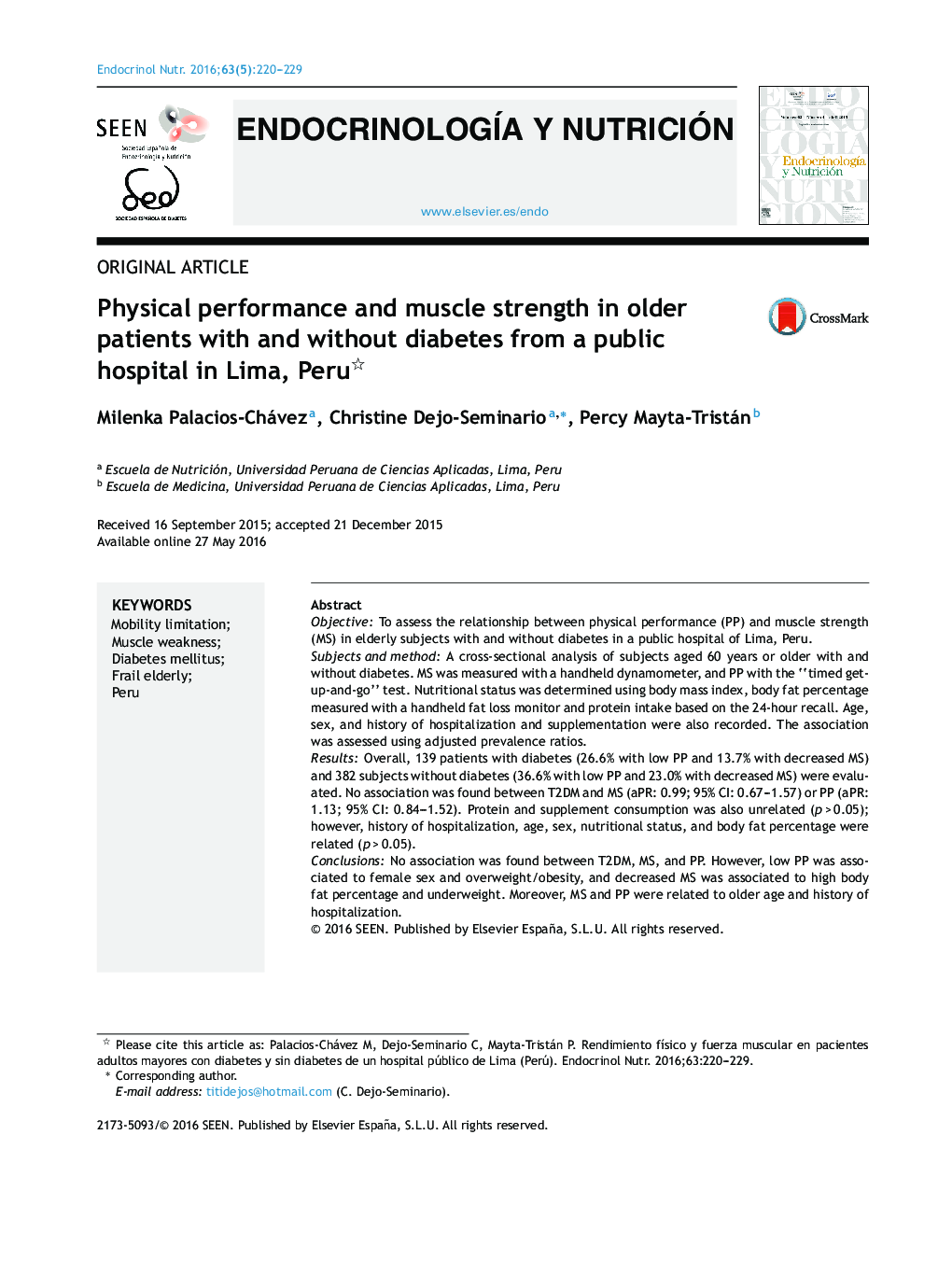| Article ID | Journal | Published Year | Pages | File Type |
|---|---|---|---|---|
| 3266824 | Endocrinología y Nutrición (English Edition) | 2016 | 10 Pages |
ObjectiveTo assess the relationship between physical performance (PP) and muscle strength (MS) in elderly subjects with and without diabetes in a public hospital of Lima, Peru.Subjects and methodA cross-sectional analysis of subjects aged 60 years or older with and without diabetes. MS was measured with a handheld dynamometer, and PP with the “timed get-up-and-go” test. Nutritional status was determined using body mass index, body fat percentage measured with a handheld fat loss monitor and protein intake based on the 24-hour recall. Age, sex, and history of hospitalization and supplementation were also recorded. The association was assessed using adjusted prevalence ratios.ResultsOverall, 139 patients with diabetes (26.6% with low PP and 13.7% with decreased MS) and 382 subjects without diabetes (36.6% with low PP and 23.0% with decreased MS) were evaluated. No association was found between T2DM and MS (aPR: 0.99; 95% CI: 0.67–1.57) or PP (aPR: 1.13; 95% CI: 0.84–1.52). Protein and supplement consumption was also unrelated (p > 0.05); however, history of hospitalization, age, sex, nutritional status, and body fat percentage were related (p > 0.05).ConclusionsNo association was found between T2DM, MS, and PP. However, low PP was associated to female sex and overweight/obesity, and decreased MS was associated to high body fat percentage and underweight. Moreover, MS and PP were related to older age and history of hospitalization.
ResumenObjetivoEvaluar la asociación entre la fuerza muscular (FM) y el rendimiento físico (RF) en adultos mayores con y sin diabetes de un hospital público de Lima (Perú).Pacientes y métodoEstudio transversal en pacientes ≥60 años con y sin diabetes. Se midió la FM con dinamómetro manual y el RF con prueba «timed get-up-and-go». Se determinó el estado nutricional con el índice de masa corporal, el porcentaje de grasa corporal con bioimpedanciómetro manual y se evaluó el consumo proteico mediante recordatorio de 24 h. Además, se registró edad, género, antecedente de hospitalización y suplementación. Se evaluó la asociación con razones de prevalencias ajustadas (RPa).ResultadosSe evaluó a 139 pacientes con diabetes (26,6% con bajo RF y 13,7% con FM disminuida) y a 382 sin diabetes (36,6% con bajo RF y 23,0% con FM disminuida). No se halló asociación de DM2 con FM (RPa: 0,99; IC 95%: 0,67-1,57) ni con RF (RPa: 1,13; IC 95%: 0,84-1,52). Tampoco se asoció el consumo proteico ni de suplementos (p > 0,05), pero sí el antecedente de hospitalización, la edad, el género, el estado nutricional y el porcentaje de grasa corporal (p < 0,05).ConclusionesNo se encontró asociación entre DM2, FM y RF. Sin embargo, el bajo RF se asoció con ser mujer y presentar sobrepeso/obesidad y tener la FM disminuida, con tener alto porcentaje de grasa corporal y bajo peso. Además, ambos se relacionaron con el aumento de edad y tener antecedente de hospitalización.
